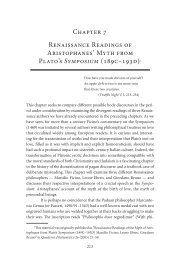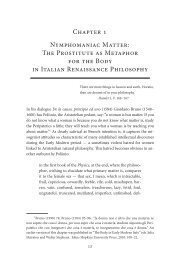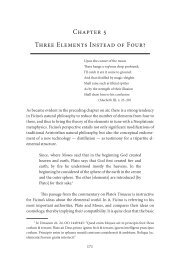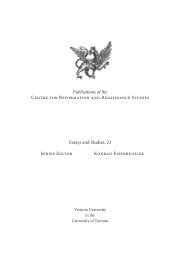Chapter 2 Matter as a Mirror: Marsilio Ficino and Renaissance ...
Chapter 2 Matter as a Mirror: Marsilio Ficino and Renaissance ...
Chapter 2 Matter as a Mirror: Marsilio Ficino and Renaissance ...
Create successful ePaper yourself
Turn your PDF publications into a flip-book with our unique Google optimized e-Paper software.
<strong>Matter</strong> <strong>as</strong> a <strong>Mirror</strong> 79<br />
that incre<strong>as</strong>ingly materialize <strong>as</strong> they p<strong>as</strong>s downwards through the hypost<strong>as</strong>es<br />
— that is the ontological entities — which <strong>Ficino</strong> equates with mirrors. 101<br />
As soon <strong>as</strong> the angels <strong>and</strong> the souls are born from him, the<br />
divine power […] infuses into them the ray in which there<br />
is a fecund power of creating all things. This imprints the<br />
arrangement <strong>and</strong> order of the whole world much more exactly<br />
in them, [the angels <strong>and</strong> souls] because they are nearer to<br />
him, than in the matter of the world. […] In the angels, these<br />
pictures are called by the Platonists archetypes or ide<strong>as</strong>; in the<br />
souls they are called re<strong>as</strong>ons or concepts; in the matter of the<br />
world they are called forms or images. They are certainly bright<br />
in the world, brighter in the soul <strong>and</strong> brightest in the angelic<br />
mind. Therefore the single face of God shines successively in<br />
three mirrors, placed in order: the Angel, the soul <strong>and</strong> the body<br />
of the world. […] In the most remote […] most dimly. 102<br />
In an important move, in this p<strong>as</strong>sage <strong>Ficino</strong> equates all the hypost<strong>as</strong>es<br />
to mirrors that reflect the divine forms. Towards the bottom of<br />
creation, these mirrors become incre<strong>as</strong>ingly unable to reproduce the divine<br />
order adequately, just <strong>as</strong> the light reflected in a series of mirrors gradually<br />
becomes fainter. The way <strong>Ficino</strong> identifies the hypost<strong>as</strong>es with mirrors alerts<br />
us to the sexual connotations of such an <strong>as</strong>cription. It again underscores the<br />
age old identification of women with mirrors, duplicity, otherness <strong>and</strong>, l<strong>as</strong>t<br />
but not le<strong>as</strong>t, reproduction; even more crucially, the impetuous nature of the<br />
primordial shadow echoes the Cl<strong>as</strong>sical Greek perception of women <strong>as</strong> wild<br />
101 <strong>Ficino</strong> identifies daemons <strong>and</strong> rays in his De vita III, 23: 377; see also <strong>Ficino</strong> (1989)<br />
271: “Et in lumine potest<strong>as</strong> quaedam est daemonica, effectrix videlicet imaginum et umbrarum,<br />
quemadmodum et daemones solent mira quaedam visa non solum dormientibus<br />
et abstractis sed etiam vigilantibus ostentare.”<br />
102 Trans. <strong>Ficino</strong> (1985) 89–91; De amore V, 4: 184–185: “Divina potest<strong>as</strong> […] statim a<br />
se natis angelis atque animis, suum illum radium in quo fecunda vis inest omnium cre<strong>and</strong>orum,<br />
[…] infundit. Hic in eis utpote sibi propinquioribus totius mundi dispositionem<br />
et ordinem multo pingit exactius quam in mundi materia. […] Picturae huiusmodi in angelis,<br />
exemplaria et idee, in animis, rationes et notiones, in orbis materia, formae atque imagines<br />
a Platonicis nominantur. Clare quidem in orbe, clariores in animo, in angeli mente<br />
clarissime. Unus igitur dei vultus tribus deinceps per ordinem positis lucet in speculis:<br />
angelo, animo, corpore mundi. […] In hoc remotissimo, […] obscurissime.”







